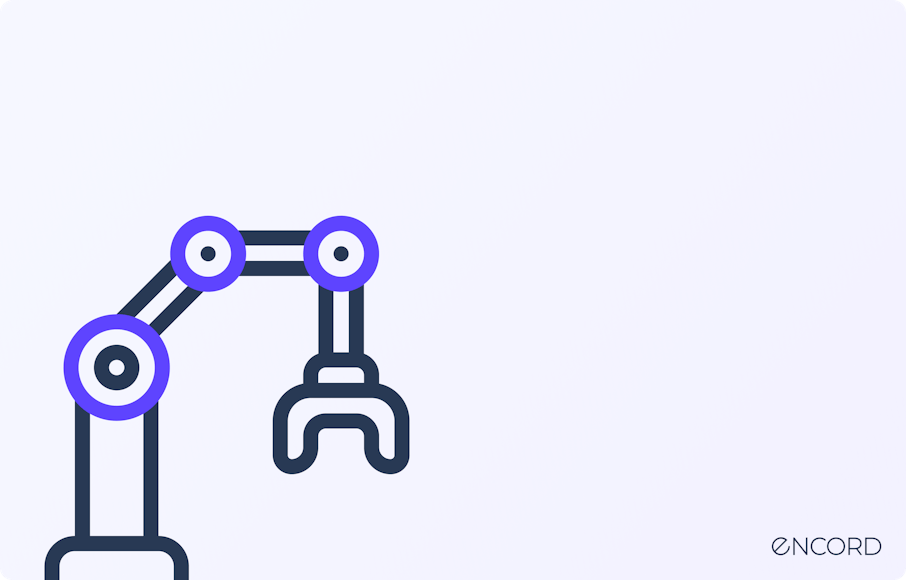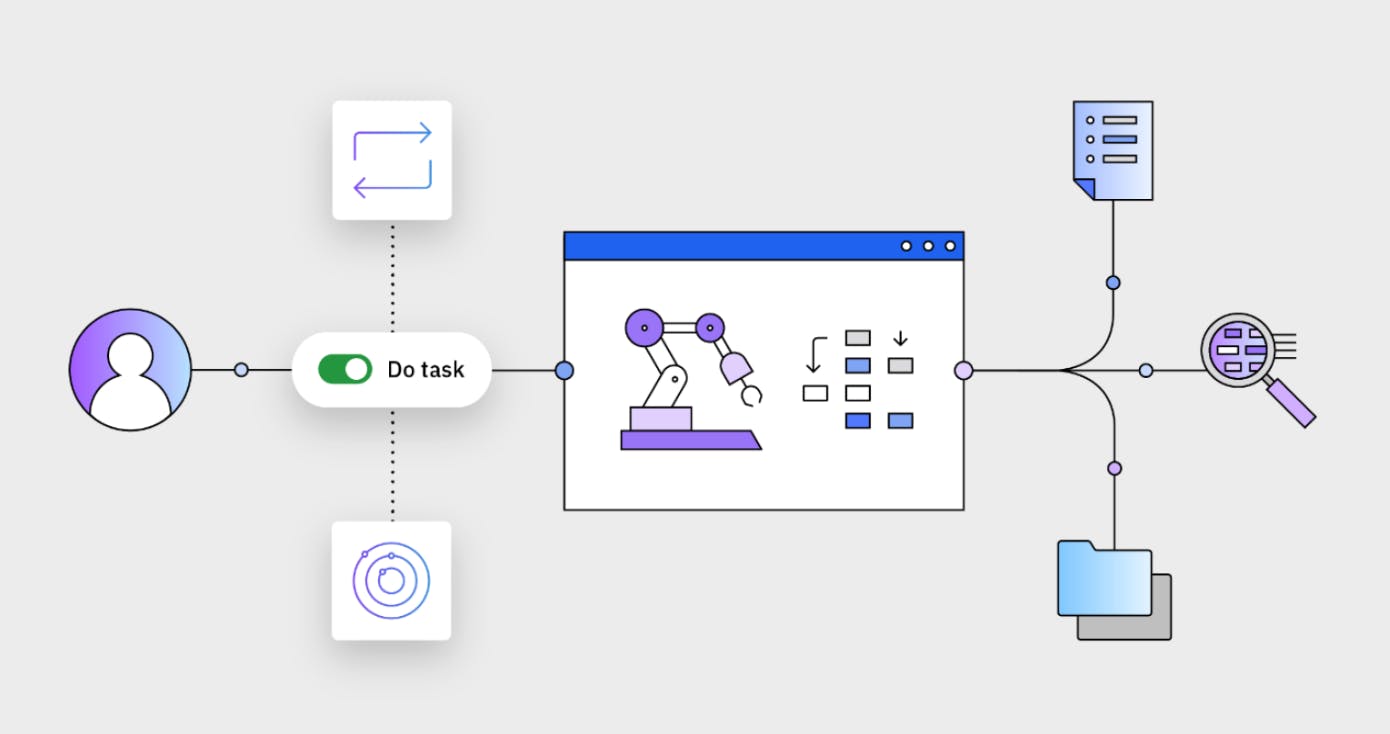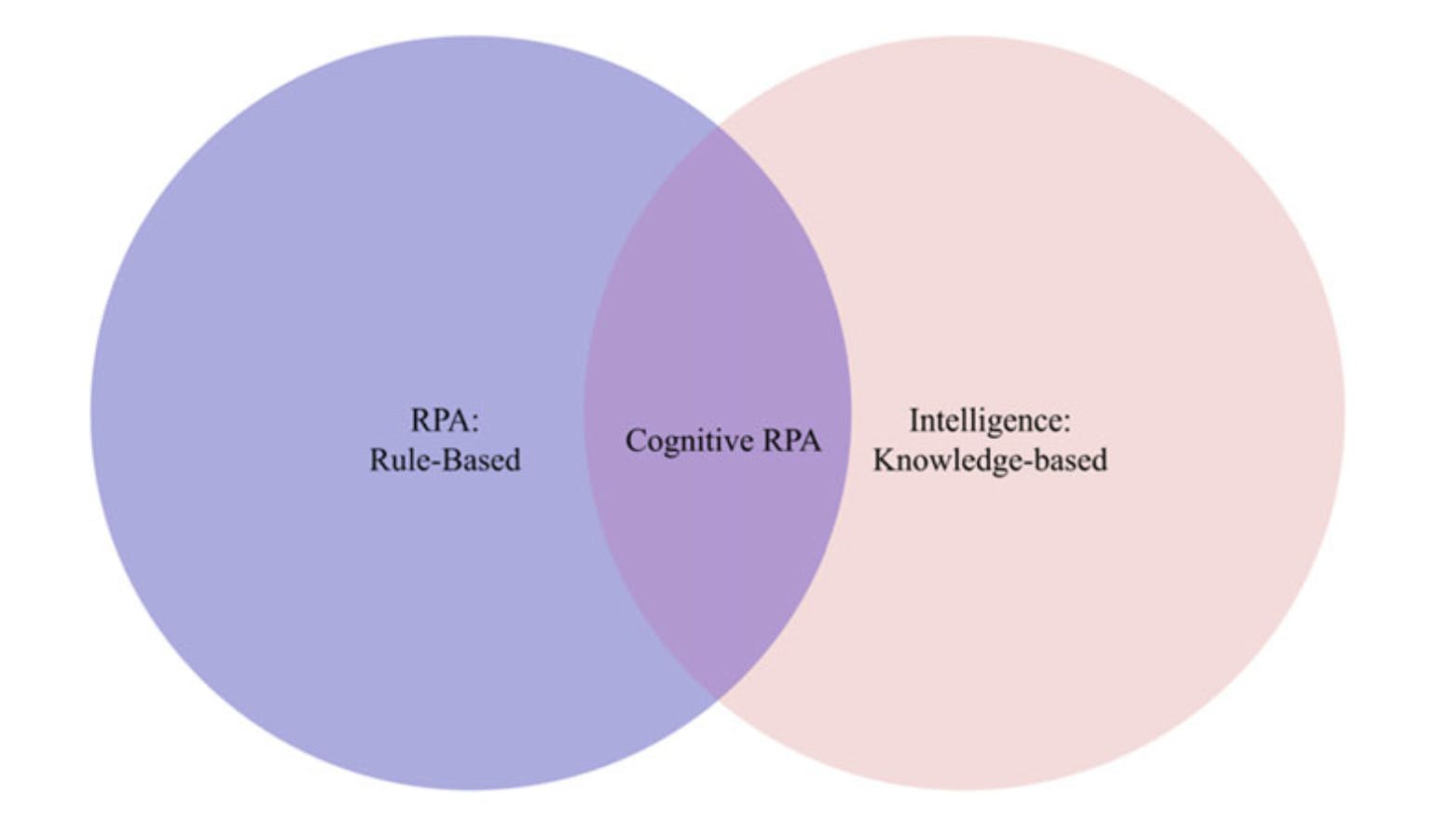Contents
Introduction to Robotic Process Automation
How Does Robotic Process Automation (RPA) Work?
Types of Robotic Process Automation (RPA)
Robotic Process Automation (RPA) and Artificial Intelligence (AI)
Benefits of Robotic Process Automation (RPA)
Challenges of RPA
Use Cases
Case Study: Role of Computer Vision in Enhancing RPA Capabilities in Healthcare
What’s Next: Cognitive Automation with Machine Vision?
Robotic Process Automation: Key Takeaways
Encord Blog
What is Robotic Process Automation (RPA)?

Robotic process automation (RPA) promotes data-driven automation and digital transformation in modern industries, or “Industrial Revolution 4.0.” Data-driven automation primarily uses insights from data to program software to improve productivity on various tasks. On the other hand, digital transformation approaches create or modify existing products and services, modify businesses, and improve efficiency, customer experience, and overall competitiveness. Modern industries, such as finance, healthcare, manufacturing, and retail, depend on RPA for many automation processes. It is assumed that RPA will overtake approximately 40% of accounting tasks by 2025, indicating a significant shift within the industry. This prediction indicates industries need to adapt RPA to streamline their workflows.
Introduction to Robotic Process Automation
RPA is an automation technology that uses software robots or robotic actors to automate repetitive manual tasks. It implements a rigid set of predefined rules and actions to streamline tasks that don’t require human effort. It even leverages technologies like artificial intelligence (AI), the Internet of Things (IoT), and even robotics to achieve automation with intelligence and efficiency.
RPA, coupled with data-driven AI approaches in the current industries, aims to reduce human workload.
A straightforward example of RPA in a banking institution is automating repetitive tasks such as data entry for customer transactions, updating customer records, and transaction validations. These processes are well structured and require clear steps and guidelines. Using RPA for such tasks is appropriate as it streamlines the process, reduces processing time, and minimizes errors.

Likewise, it can be seamlessly integrated with other technologies like blockchain, cloud computing, AR, VR, etc. This improves their capabilities and enables greater productivity, cost savings, and scalability.
The traditional way of automating, which involved heavy coding, macro recording, playback, integrating APIs, etc., was slow, complex, and required intensive programming. RPA, on the other hand, offers a sharp contrast. It addresses those issues for automation to be accessible to the masses with its less-code functionality, shallow learning curve, and adaptability.
How Does Robotic Process Automation (RPA) Work?
Implementing RPA typically follows a structured, four-step process:
- Understanding the process requires reading the documentation, observing the process, conducting interviews with stakeholders, and conducting user testing. These will provide a list of requirements that adhere to the task and factors affecting the process.
- Defining workflow automation requires designing the process according to the specific requirements and the complexity of tasks. Depending on the available tools, this may require using low-code platforms with intuitive drag-and-drop interfaces or more advanced systems incorporating machine learning to process unstructured data like text from emails or documents.
- Integrating with existing systems or processes ensures that RPA bots have the necessary access to perform tasks by interacting with databases, applications, and other digital platforms. Effective integration enables data flow and task execution within the automated workflow.
- Workflow monitoring and optimization are essential, as they involve overseeing the execution of RPA bots, tracking performance metrics, and identifying any anomalies or issues that may arise during operation. Proactive monitoring enables timely intervention and optimization, ensuring smooth and reliable automation processes.
With these steps, you can effectively implement RPA in your workflow. So far, we have seen how RPA benefits repetitive and mundane tasks with a given set of rules. But there are instances where automation can be more than just defining workflows.
Sometimes, RPA must reason and make decisions based on the circumstances or data provided. In the next section, we will explore the different types of RPA that satisfy the previous statement.
Types of Robotic Process Automation (RPA)
Let us briefly explore how RPA has evolved from a more traditional rule-based automation system to a more intelligent and dynamic data-driven automation technology.
Traditional RPA
Traditional RPA is designed to automate structured, rule-based tasks that do not require human judgment or decision-making. This approach utilizes predefined steps and workflows to execute repetitive tasks such as data entry, extraction, form filling, and transaction processing.
Traditional RPA is highly effective in streamlining operations that follow a consistent pattern, reducing manual effort and error rates in tasks like invoice processing and routine data management.
Applications and Implications of Traditional RPA
- Automate Logical and Straightforward Tasks: Traditional RPA is ideal for businesses that automate straightforward, voluminous tasks to increase efficiency and accuracy. For example, automating the invoice data entry process can significantly speed up accounts payable operations.
Cognitive RPA
Cognitive RPA extends the capabilities of traditional automation by integrating artificial intelligence (AI) and machine learning (ML) technologies. This advanced form of RPA can process structured and unstructured data, enabling it to perform tasks requiring contextual understanding, learning from patterns, and making decisions.

RPA Revolution in the Healthcare Industry During COVID-19
Cognitive RPA applications include natural language processing (NLP) and large language models (LLMs) for interpreting human language, sentiment analysis for gauging customer feedback, and image recognition for analyzing visual data.
Applications and Implications:
- Managing Complex Processes: Cognitive RPA is adept at handling complex processes such as customer service inquiries and analyzing large volumes of diverse data for insights because it adapts to changes and makes informed decisions.
- Context-aware Automation: It is suited for more complex challenges like automated customer support, where it can analyze inquiries, understand context, and provide personalized responses.
Attended Automation
Attended automation involves human collaboration as it works on the cues given by an operator. It is essentially a virtual assistant aiming to boost an individual’s productivity on repetitive tasks. It is also considered a front-end automation tool. It is quite useful for tasks that require human input and judgment to execute a process.
Applications and Implications
- Human + RPA: It is effective for scheduling appointments, customer service interactions, and data validation, where human expertise complements automated processes.
- Front-office Tasks: It is primarily preferred for tasks such as receptions, flight booking, check-in automation, etc.
Unattended Automation
Unattended automation provides an end-to-end automated solution with no human involvement. The bots are independent and automate the entire workflow. In this case, the RPA is provided with a sequential and clear step to execute.
This type of automation is suitable for executing long processes and works on dedicated machines. An orchestrator allows you to manage tasks by scheduling the entire workflow. You can trigger, monitor, and track your bots with an orchestrator.
Applications and Implications
- They are suitable for backend processes. They can handle complex tasks like data processing, orchestrating various virtual machines, high-volume transaction processing, data migration between systems, etc.
Hybrid Automation
Hybrid automation combines attended and unattended automation. In this type of RPA, communication happens between both processes. Additionally, it combines human involvement and backend operations.
The “attended bots” receive instructions from the human worker and initiate the process. If the process requires triggering unattended bots, these attended bots can do so. Upon triggering, the unattended bots do what they are best at—providing an end-to-end automated service. Once the task is completed, the unattended bots send the data or output to the attended bot, which notifies the human worker for further human input.
Unattended robots handle tasks like data processing, report generation, etc. that don't require human involvement. On the other hand, attended robots handle tasks that require human attention, like gathering data.
Applications and Implications
- Handling Complex Tasks: Hybrid automation excels in airport security check-in, order/delivery routing, inventory management, candidate screening, and interview scheduling.
Robotic Process Automation (RPA) and Artificial Intelligence (AI)
In the previous section, we discussed how powerful Cognitive RPA is and how it can handle complex tasks using tools like neural networks and other ML approaches. RPA and AI are powerful individually, but combined, they can achieve and excel much more. This section will discuss how AI can improve RPA capabilities and functionality.
Integrating RPA with Computer Vision
Let’s discuss in detail how AI can enhance the automation capabilities of RPA via computer vision (CV).
To begin with, we must understand the complexities associated with an image dataset. Image data contains a lot of details and variability. Variability is one of the biggest concerns as it can portray diverse visual and content characteristics, including differences in size, shape, lighting, etc.
The same object captured from different distances can portray different information. However, the same variability in the image contains rich information that, if leveraged properly, can help us get better information about the data.
Once the segmentation masks are applied to each image, you can use RPA to automate various tasks. For example:
- It can automate the task of segregating cars and trucks into folders.
- It can extract and log individual images into a database or a spreadsheet
- RPA can trigger actions that initiate other required workflows or notifications based on the extracted data.
You can see how versatile and beneficial RPA and AI can become when they are combined. You can use AI to perform complex tasks like image segmentation and annotation. However, RPA can build an automated pipeline based on the segmented and annotated images.
Now, let’s find out the additional advantages that RPA offers.
Benefits of Robotic Process Automation (RPA)
In this section, we will briefly discuss some of RPA's advantages. This will give you insight and help you make informed decisions about implementing RPA in your workflow and businesses. Below are some of the advantages.
Low-code Development
You can configure RPA software as it offers a UI drag-and-drop feature to define the automation process. This allows users to correctly, logically, and sequentially place the suitable automation component. It also facilitates rapid prototyping, a shallow learning curve, quicker deployment, and even improves collaboration.
Increased Efficiency and Productivity
RPA reduces human intervention and friction, allowing organizations to automate tasks consistently. This offers an efficient and streamlined workflow, which increases productivity. For example, automating invoice processing, payroll management, data migration, report generation, etc.
Cost Savings through Automation
RPA reduces human input and workload costs. This means routine work can be done cheaply, and human input can be used in other important areas. By automating repetitive tasks, RPA can save companies 30 to 50% in processing costs. Compared to manual work and traditional methods, this leads to a positive ROI within one year.
Improved Accuracy and Compliance
As we configure RPA bots with specific predefined rules, we constrain the bots to do that certain task. RPA can improve accuracy for repetitive tasks with well-defined rules by eliminating human error from fatigue and distractions.
RPA software is easy to learn and deploy, and it offers the additional advantages of scalability and efficiency, economic friendliness, and workload reduction. However, it also has challenges. The following section will delve into some of RPA's challenges.
Challenges of RPA
We have seen how RPA benefits our repetitive, tedious, and mundane tasks. However, there can be instances where RPA can fail if the task is not correctly defined. Issues can also arise when working with data, among others. Let us now see four common challenges that RPA usually faces.
Complexity of Process Identification
When automating workflow, it is essential to understand the process because automating the wrong tasks can be detrimental. Carefully analyzing workflows and selecting well-defined, repetitive processes with clear inputs and outputs is essential for success.
Integration with Legacy Systems
Many organizations utilize older systems not designed for seamless integration with modern automation tools. This can require technical expertise and adaptation to overcome compatibility issues.
Security and Compliance Concerns
Integrating RPA introduces new access points and data flows. Robust security measures, including data encryption and access controls, are vital to ensure compliance and safeguard sensitive information.
Resistance to Change and Organizational Culture
Embracing automation often requires organizational shifts and employee training. Addressing concerns about job displacement, upskilling human workers, and fostering a culture of innovation are key to smooth adoption.
These challenges often act as a roadblock that may hinder many workflow processes. But if these challenges are carefully addressed, they can help us break barriers and offer new solutions.
Despite the challenges represented in this section, many industries have never refrained from implementing RPA in their workflow. You will learn some of these in the next section.
Use Cases
This section will discuss three primary industries that use RPA to streamline operations. The industries mentioned here have one thing in common: supply and demand. Because of this factor, freeing up the human workload and automating repetitive and exhausting processes is essential.
Healthcare
Healthcare organizations are one of the most demanding places where many things can be automated. Because of the ongoing patient visits, especially in hospitals, attending to patients remains a vital obligation compared to other mundane and repetitive tasks. Some of the areas that can be automated using RPA are:
- Claims Processing: Automating tasks like eligibility verification, data entry, and claims submission can save time, increase accuracy, and improve reimbursement cycles.
- Patient Scheduling and Registration: Automating appointment scheduling via the RPA app can reduce administrative burden.
- Medical Report Generation: Extracting high-volume data from various sources, such as imaging technologies, and generating standardized reports will reduce doctors' and clinicians' workload for patient care.
- Fraud Detection and Red-Teaming: Analyzing claim data to identify and flag potential fraudulent activity improves healthcare system security and integrity. As patient data requires high security, RPA can also automate various infiltration tests on the healthcare system to check its reliability and security.
Retail
With the rise of e-commerce and consumer demands, modern retail has enlarged its territory. Here are three ways in which the retail sector is using RPA:
- Order Processing and Fulfillment: Receiving orders from customers and their delivery is one of the critical jobs of retail. These can be automated using RPA, and customers can be notified regarding each process phase, such as order processing, shipping, etc. This enhances order accuracy and expedites delivery.
- Customer Service: Chatbots powered by RPA can handle routine inquiries, freeing up human agents for complex issues and improving customer experience.
- Price Management and Promotions: Automating tasks like price comparisons, discounts based on customer involvement, and campaign execution can promote dynamic pricing strategies and targeted promotions.
Supply Chain Management
RPA technology has a more significant impact on the supply chain, essentially orchestrating the exchange between various networks. It includes managing and storing raw materials, manufacturing, moving, delivering, and storing finished products in a warehouse.
This is how RPA implementation enhances the supply chain.
- Purchase Order Processing: RPA automates vendor communication, purchase order generation, and approval cycles, streamlining procurement processes.
- Improving Supply Chain Planning: RPA can automate data analysis for forecasting and recent trends in markets and products. This eventually promotes better demand planning and inventory management.
- Logistics and Transportation: Using RPA to automate shipment tracking and route optimization improves logistics efficiency and reduces delays.
Case Study: Role of Computer Vision in Enhancing RPA Capabilities in Healthcare
In healthcare, a large part is devoted to imaging technology and visual data. For instance, radiology depends on X-rays, CT scans, and other imaging technologies to diagnose and treat patients. Some challenges revolve around this type of data:
- Image Analysis: Analyzing such images is hard and time-consuming. On average, a radiologist takes about 8 to 10 minutes, sometimes more if the image needs clarification.
- Workload Management: Understanding these images takes a lot of time, so it can be exhausting for radiologists to continuously read them and manage other obligations such as attending to the patient and counseling. Additionally, mental exhaustion can cause them to lose focus and make errors in diagnosis and treatment.
- Report Generation: This is another phase where radiologists struggle to focus on generating the right and precise patient report through the scan.
Overcoming RPA Challenges by Using Computer Vision
Traditional RPA can automate the above challenges with a predefined script but can be inefficient. However, certain tasks like fetching and organizing images can save radiologists time, but they might not be beneficial for complex tasks. This is because the automation script will mostly contain general steps. The software can make errors in anomalies and unclear images and provide the wrong solutions.
For instance, the software may need to analyze the image and correctly interpret the data. Similarly, the software may fail to find anomalies, increase the rate of false positives and negatives, or misclassify the image. If those two cases occur, considerable errors in report generation could lead to the wrong diagnosis and treatment.
Computer vision (CV) can be coupled with RPA to address these issues. CV is one of those approaches where you extract rich data representations from visual data. Using CV, RPA can utilize these representations that allow the software to interpret the images and make the right decision.
With this combination of AI and RPA, radiologists can quickly receive and review accurate image analysis. This reduces their workload, allowing them to attend to patients or take on complex cases.
Additionally, this system can generate reports that the radiologist can review and approve. In a nutshell, systems like this can improve radiologists' accuracy, efficiency, and workload management.
But on the downside, these AI systems need to be trained on a large dataset, which generally takes a lot of time.
What’s Next: Cognitive Automation with Machine Vision?
Cognitive automation has shown great potential, as it can efficiently handle complex tasks. As such, it holds great significance in Machine Vision. A subfield also uses cameras and sensors to get the input data. Modern industrial practices rely on the vision system to manufacture products and services.
Cognitive automation with machine vision can enhance industries to make data-driven decisions, optimize operations, predict challenges, and improve efficiency across various sectors, such as scaling up and down based on requirements, strategic planning, etc. For instance:
- Companies developing autonomous vehicles use cameras and sensors to capture environmental data. Cognitive automation processes this data for decision-making, such as updating ML models with anomalies or new insights and integrating them into training simulations. Additionally, it can analyze familiar data, aiding predictive analytics. In the future, cognitive automation may facilitate vehicle-to-vehicle communication, enhancing safety.
- In manufacturing, vision systems are pivotal for product analysis and robot navigation. When combined with cognitive automation, new opportunities arise. For instance, it can identify bottlenecks like raw material shortages and automate orders. Furthermore, it can monitor product quality, gather user feedback, and suggest design improvements for future development.
These technologies can promote human-machine collaboration, creating new spaces for innovation and engineering. This can ultimately lead to offering new and better product designs and services and reducing waste.
Robotic Process Automation: Key Takeaways
Robotic Process Automation as automation software and solutions rapidly transforms our work across different fields and processes. With advancements in AI, RPA implementation can be significantly enhanced to boost industrial productivity in a much more innovative way.
As automation technology continues to evolve with RPA, the impact of automation solutions will only grow. They will reshape workflows and open doors for even greater automation possibilities. This will eventually drive research and development in many areas, promoting the betterment of human lives.
While challenges exist, its potential for increased efficiency, reduced human error, accuracy, and cost savings is undeniable. Organizations can resolve these challenges by proactively adopting responsible development practices. They can use RPA to navigate the future of work effectively and unlock its full potential for success.

Explore our products
- Some of the challenges faced while implementing robotic process automation include identifying suitable processes, managing resistance to change, and ensuring compatibility with existing systems
- One major limitation of RPA is its inability to handle unstructured data. Other limitations include dependence on a rigid and stable set of rules.
- Implementation timelines for RPA projects vary but can typically range from weeks to several months, depending on complexity and scale.
- RPA can automate repetitive, rule-based tasks, such as data entry, invoice processing, and customer service operations.
- RPA is unsuitable for complex decision-making tasks, unstructured data handling, or continuous learning beyond predefined rules.
- Most businesses need RPA to increase efficiency, reduce costs, improve accuracy, and reallocate human resources to more strategic and decision-making tasks.
- RPA vulnerabilities include security risks such as unauthorized access or data breaches, potential errors in automated processes, and dependency on third-party tools.




